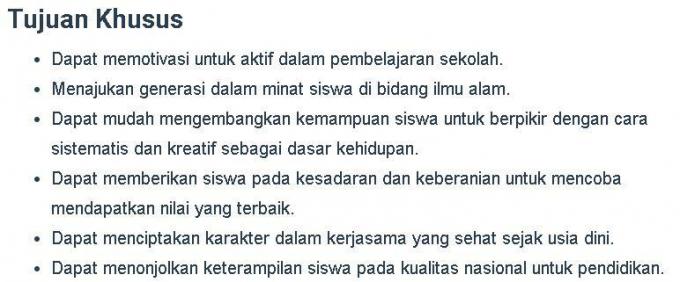Questions for the 2021 National High School Biology Olympiad & Discussion
Hello friends this time formula.co.id will provide a discussion of articles on Biology Olympiad Problems at the high school / national or provincial level & discussion, class year 2020/2021 to add insight to all of us.
High School Biology Olympiad – This is the basic material for the implementation of the national examination stage based on activities in national competitions and internationally, so that the national science competition (KSN) is carried out at the national level with the development of technology from his field.
This can also maximize the potential and talent to develop the good name of Indonesia by participating as well as in Olympic competitions based on the quality of students to achieve higher qualifications good.
Just take a look at the discussion below…?
High School Biology Olympiad Practice Questions


Also Read: Middle School Biology Olympiad Questions
Sample questions for high school biology olympiada
1. In some animal species, males and females look different. This is an example of.
A. genetic drift
B. Coevolution
C. Character shift
D. sexual selection
2. In an attempt to clone a human protein, material from a human cell was inserted into it.
Bacteria The material of cells in humans is.
A. DNA segment encoding the mRNA transcript
B. rRNA and tRNA are used during the translation process
C. Proteins that code for nuclear mRNA
D. mRNA proteins found in the cytoplasm
3. A big blizzard drastically reduces the population and its results
loss of some alleles in the gene pool. This is an example of.
A. genetic drift
B. Coevolution
C. Character shift
D. sexual selection
4. Flies and dragonflies can live in the same ecosystem because.
A. occupy another niche
B. both are commensalism
C. Both are insects
D. Dragonflies have stronger wing muscles than flies every day
5. Legumes are good for the soil because.
A. They won't eat deer
B. are photosynthetic plants
Has nitrogen fixing bacteria in the roots
D. Animals can turn it into energy
6. If the DNA sequence 5 is 'TACAGA 3', then the complementary mRNA sequence is.
A. 3'UCUAUG5'
B. 3 'TACAGA5'
C. 3 'AUGUCU5'
D. 3 'UACAGA5'
7. Species that reproduce sexually have a selective advantage over species that reproduce asexually because of sexual reproduction.
A. More efficient in energy consumption
B. allows for higher genetic diversity
C. reduce mutations
D. Always reduce the survivability of offspring
Also Read: High School Physics Olympiad Questions
8. Genes encoding protein sequences in eukaryotes are passed from generation to generation in.
A. other proteins
B. rRNA
C. tRNA
D. mRNA
9. The following are examples of parasitism, EXCEPT.
A. Birds and rhinos
B. viruses and host cells
C. Tapeworms and humans
D. Tuberculosis and Human Bacteria
10. Meiosis differs from mitosis in that.
- I. Where does cell division occur
- II.. DNA replication during interphase
- III. Haploid cells are made of diploid cells
A. only me
B. only II
C. only III
D. I and II
11. Stomata on leaves close at night to prevent loss.
A. O2
B. H2O
C. CO2
D. Energy
Also Read: Middle School Physics Olympiad Questions
12. If calcium binds to troponin in muscle cells, which bonds are exposed?
A. tropomyosin
B. Myosin
C. ATP
D. ADP
13. Use all organisms.
A. CO2
B. Triplet genetic code for protein production
C. Oxygen
D. ADP as cellular energy
14. The gene for the wing type in fruit flies is located on the autosomal chromosome. The allele for the wild-type (dominant) wing dominates the residue (shorter size). If homozygous male flies are mostly crossed with female remains, what percent of female offspring have wild-type wings?
A. 0%
B. 25%
C. 50%
D. 75%
15. Perhaps the first organisms on earth.
A. autotroph
B. chemosynthetics
C. heterotroph
D. produce oxygen
16. Maple trees, apple trees, orchids and palm trees are examples.
A. Gymnosperms
B. bryophytes
C. angiosperms
D. chlorophyte
17. Mucus and yeast are classified as.
A. rhodophyta
B. bryophytes
C. Mushroom
D. ciliate
18. In humans, brown eyes dominate blue eyes. What is the percentage of offspring that have brown eyes in the BB x BB cross.
A. 75%
B. 50%
C. 0%.
D. 100%
Also Read: Elementary Physics Olympiad Questions
19. In normal human sperm.
- I. X chromosome
- II, 23 pairs of chromosomes
- III. Y chromosome
A. Only me
B. II only
C. Only III
D. I and II
20. The following, which have bilateral symmetry, are.
A. planaria
B. Giligworms
C. person
D. arthropod
21. The Latin name for the rat is Mus musculus. Mus is.
A. phylum
B. Class
C. Order
D. genus
22. Albinos have a genotype, while other members of the population are either AA or Aa. The offspring resulting from a cross between a herterozygous male and an albino female are.
A. 100% albino
B. 100% normal
C. 50% normal, 50% albino
D. 25% normal, 75% albino
23. What part of cellular respiration directly creates a pH gradient during oxidative carbohydrate metabolism.
A. Glycolysis
B. Anaerobic breath
C. Cancer Cycle
D. Electron transport chain
Also Read: Ips Elementary Olympiad Questions
24. The difference between fat and carbohydrates is.
A. Carbohydrates are always steroids
B. Carbohydrates have an H: O ratio = 2:1
C. Fat is known as starch
D. Fats have an H: O ratio with more oxygen than hydrogen
25. Water diffuses through.
A. Carrier protein
B. Simple system
C. ion channel
D. osmosis
26. Smooth muscles are formed from.
A. Endoderm
B. Mesoderm
C. epidermis
D. ectoderm
27. Transport movement in a cell that is not symmetrical is.
A. Transport from the rhizoderm to the cortex.
B. Cortex to endoderm
C. Endoderm becomes pericycle
D. Pericycle to Xylem
28. What is the function of the cork cambium?
A. Produces new leaves.
B. generate new ship network
C. creates a protective layer on secondary growth
D. creates a protective layer in the epidermis
29. The Z-mammal cell strain grown in tissue culture had double-stranded DNA of 2.4 meters/cell. The S-phase time of the cell is known to be 5 hours. If the rate of DNA synthesis
Just in this cell of 20 m/min, how many replication forks must be formed during the process of DNA replication of the cell?
A. 24000
B. 800
C. 400
D. 100
30. After four generations of maintaining a small effective population size, the mouse population increased due to mating. Although the initial heterozygosity is x, after 4 generations it becomes 0.5x. If a pair of mice has two different alleles at a particular gene location, then the probability that the individual.
- 4th generation has two alleles
- identical in the same place
A. 0.25 + x
B. 0.25x
C. 0,5
D. 0
That's our discussion about the most complete biology olympiad for high school level, hopefully from what we have reviewed above it can be useful and easy to understand, thank you so much.
Also Read: High School Ips Olympiad Questions
